Abstract
To investigate the long-term survival rate of node-positive (pN+) breast cancer treated by locoregional therapy alone, we made an attempt to identify all such patients followed up for at least 15 years after treatment in a defined geographical area (city of Turku, Southwestern Finland) and time period (1945-79) using the files of the local hospitals and the Finnish Cancer Registry. The clinical and autopsy records and histological slides of 1172 women diagnosed with breast cancer in the city were reviewed. From this cohort we identified 339 women with unilateral node-positive breast cancer treated with locoregional therapy without systemic adjuvant therapy. The relative survival rate of the cohort compared with the general female population matched for age and year of follow-up was calculated. The 15- and 30-year survival rates corrected for known intercurrent deaths were 26% (95% CI, 21-31%) and 21% (16-26%) respectively, and the relative survival rates 23% and 21% respectively. None of the patients with pN2 disease survived for 15 years, whereas the 30-year corrected survival rate in pN1 disease was 24% (18-30%). Women with pT1N1M0 cancer had as high as 59% (43-75%) 15-year survival rate corrected for intercurrent deaths. A trend for improving survival was found by the decade of diagnosis. The results indicate that a considerable proportion of women with pN1 breast carcinoma treated with locoregional therapy alone become 30-year survivors and are probably cured. Adequate locoregional treatment is mandatory in the care of node-positive breast cancer.
Full text
PDF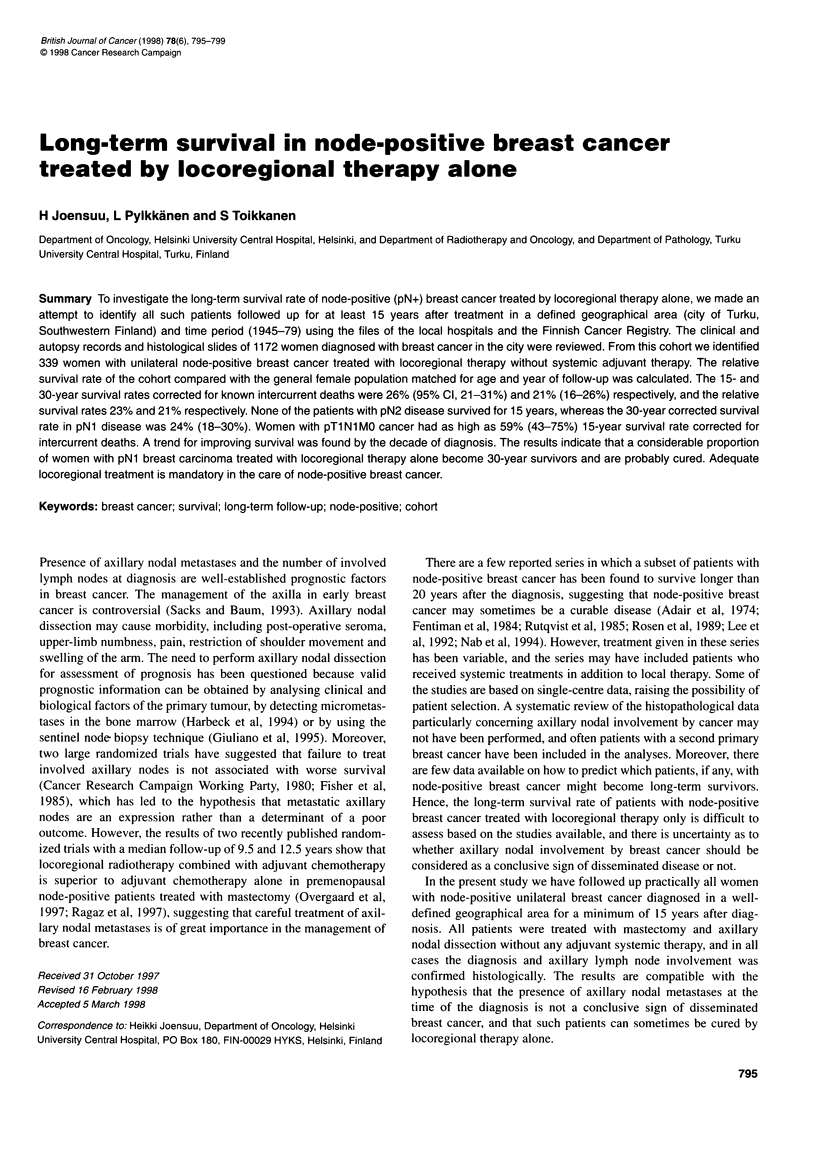
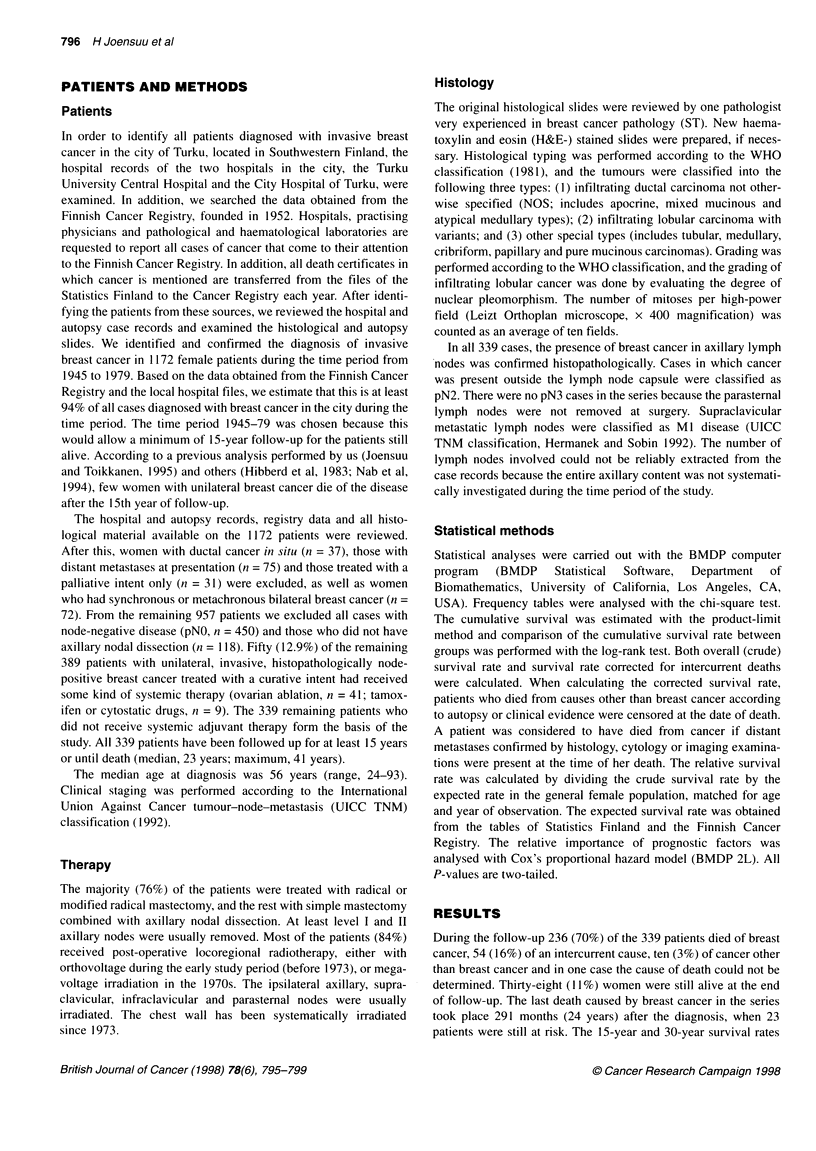
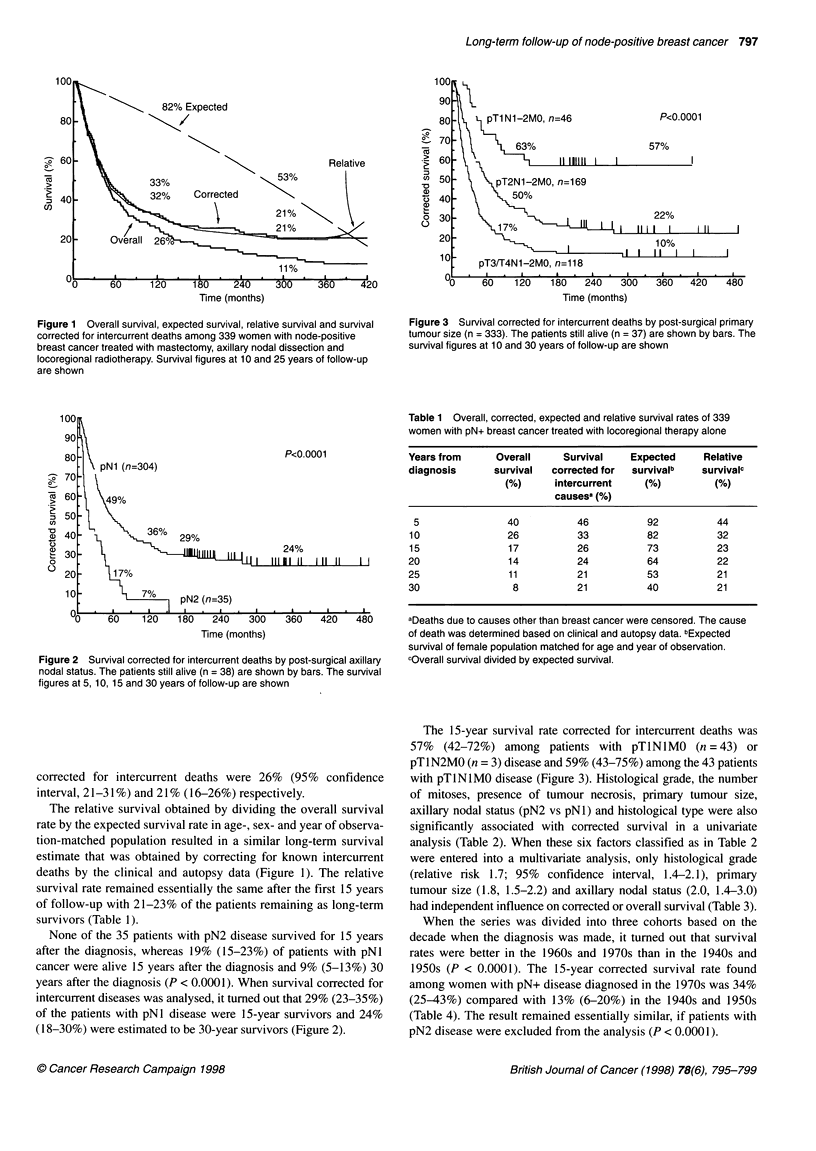
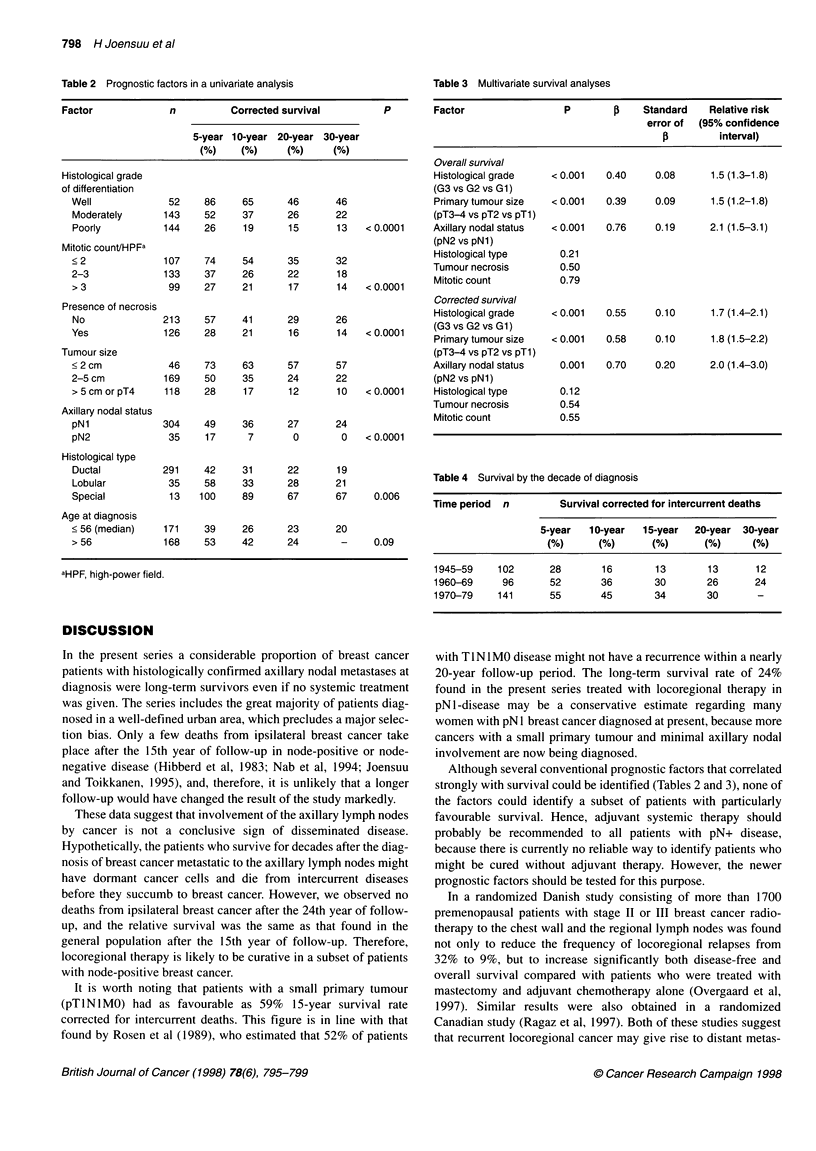
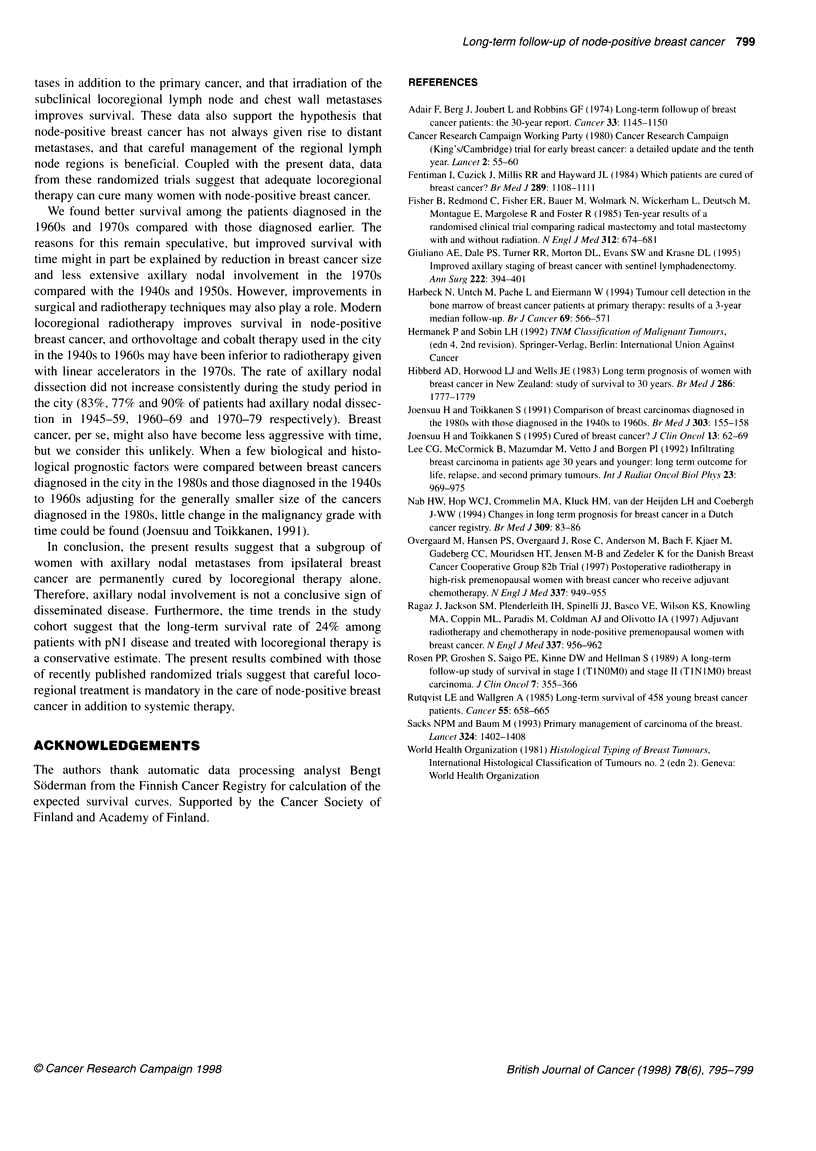
Selected References
These references are in PubMed. This may not be the complete list of references from this article.
- Adair F., Berg J., Joubert L., Robbins G. F. Long-term followup of breast cancer patients: the 30-year report. Cancer. 1974 Apr;33(4):1145–1150. doi: 10.1002/1097-0142(197404)33:4<1145::aid-cncr2820330438>3.0.co;2-0. [DOI] [PubMed] [Google Scholar]
- Fentiman I. S., Cuzick J., Millis R. R., Hayward J. L. Which patients are cured of breast cancer? Br Med J (Clin Res Ed) 1984 Oct 27;289(6452):1108–1111. doi: 10.1136/bmj.289.6452.1108. [DOI] [PMC free article] [PubMed] [Google Scholar]
- Fisher B., Redmond C., Fisher E. R., Bauer M., Wolmark N., Wickerham D. L., Deutsch M., Montague E., Margolese R., Foster R. Ten-year results of a randomized clinical trial comparing radical mastectomy and total mastectomy with or without radiation. N Engl J Med. 1985 Mar 14;312(11):674–681. doi: 10.1056/NEJM198503143121102. [DOI] [PubMed] [Google Scholar]
- Giuliano A. E., Dale P. S., Turner R. R., Morton D. L., Evans S. W., Krasne D. L. Improved axillary staging of breast cancer with sentinel lymphadenectomy. Ann Surg. 1995 Sep;222(3):394–401. doi: 10.1097/00000658-199509000-00016. [DOI] [PMC free article] [PubMed] [Google Scholar]
- Harbeck N., Untch M., Pache L., Eiermann W. Tumour cell detection in the bone marrow of breast cancer patients at primary therapy: results of a 3-year median follow-up. Br J Cancer. 1994 Mar;69(3):566–571. doi: 10.1038/bjc.1994.103. [DOI] [PMC free article] [PubMed] [Google Scholar]
- Hibberd A. D., Horwood L. J., Wells J. E. Long term prognosis of women with breast cancer in New Zealand: study of survival to 30 years. Br Med J (Clin Res Ed) 1983 Jun 4;286(6380):1777–1779. doi: 10.1136/bmj.286.6380.1777. [DOI] [PMC free article] [PubMed] [Google Scholar]
- Joensuu H., Toikkanen S. Comparison of breast carcinomas diagnosed in the 1980s with those diagnosed in the 1940s to 1960s. BMJ. 1991 Jul 20;303(6795):155–158. doi: 10.1136/bmj.303.6795.155. [DOI] [PMC free article] [PubMed] [Google Scholar]
- Lee C. G., McCormick B., Mazumdar M., Vetto J., Borgen P. I. Infiltrating breast carcinoma in patients age 30 years and younger: long term outcome for life, relapse, and second primary tumors. Int J Radiat Oncol Biol Phys. 1992;23(5):969–975. doi: 10.1016/0360-3016(92)90901-s. [DOI] [PubMed] [Google Scholar]
- Nab H. W., Hop W. C., Crommelin M. A., Kluck H. M., van der Heijden L. H., Coebergh J. W. Changes in long term prognosis for breast cancer in a Dutch cancer registry. BMJ. 1994 Jul 9;309(6947):83–86. doi: 10.1136/bmj.309.6947.83. [DOI] [PMC free article] [PubMed] [Google Scholar]
- Overgaard M., Hansen P. S., Overgaard J., Rose C., Andersson M., Bach F., Kjaer M., Gadeberg C. C., Mouridsen H. T., Jensen M. B. Postoperative radiotherapy in high-risk premenopausal women with breast cancer who receive adjuvant chemotherapy. Danish Breast Cancer Cooperative Group 82b Trial. N Engl J Med. 1997 Oct 2;337(14):949–955. doi: 10.1056/NEJM199710023371401. [DOI] [PubMed] [Google Scholar]
- Ragaz J., Jackson S. M., Le N., Plenderleith I. H., Spinelli J. J., Basco V. E., Wilson K. S., Knowling M. A., Coppin C. M., Paradis M. Adjuvant radiotherapy and chemotherapy in node-positive premenopausal women with breast cancer. N Engl J Med. 1997 Oct 2;337(14):956–962. doi: 10.1056/NEJM199710023371402. [DOI] [PubMed] [Google Scholar]
- Rosen P. R., Groshen S., Saigo P. E., Kinne D. W., Hellman S. A long-term follow-up study of survival in stage I (T1N0M0) and stage II (T1N1M0) breast carcinoma. J Clin Oncol. 1989 Mar;7(3):355–366. doi: 10.1200/JCO.1989.7.3.355. [DOI] [PubMed] [Google Scholar]
- Rutqvist L. E., Wallgren A. Long-term survival of 458 young breast cancer patients. Cancer. 1985 Feb 1;55(3):658–665. doi: 10.1002/1097-0142(19850201)55:3<658::aid-cncr2820550331>3.0.co;2-p. [DOI] [PubMed] [Google Scholar]
- Sacks N. P., Baum M. Primary management of carcinoma of the breast. Lancet. 1993 Dec 4;342(8884):1402–1408. doi: 10.1016/0140-6736(93)92759-m. [DOI] [PubMed] [Google Scholar]


